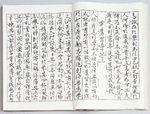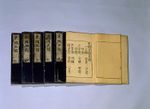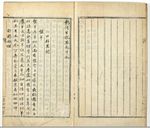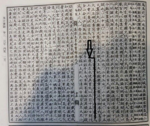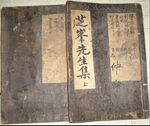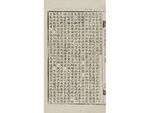2017 JSG Summer Hanmun Workshop (Intermediate)
목차
- 1 Description
- 2 Class
- 3 Translation
- 4 강독과제 Reading and Translation Assignments
- 5 장기 번역 과제
- 5.1 1. Kyŏngmong yogyŏl(擊蒙要訣) translated by Sanghoon Na
- 5.2 2. Tongguk Chŏng'un Sŏ(東國正韻序) translated by Younès M'Ghari
- 5.3 3. Chuk puin chŏn(竹夫人傳) translated by Petra Sváková
- 5.4 4. Yŏrha ilgi(熱河日記 - 口外異聞) translated by Student 4
- 5.5 5. 朝鮮王朝實錄 高宗實錄 3年2月25日 translated by Jae Yong Chang
- 5.6 6. Xunerzhenyan(訓兒眞言) translated by Goeun Lee
- 5.7 7. Text translated by Student 7
- 5.8 8. The compendium of Chibong 芝峯集 - translated by Bryan Sauvadet
- 5.9 9. Text translated by Student 9
- 5.10 10. Text translated by Student 10
- 5.11 11. Text translated by Student 11
- 5.12 12. 孝宗實錄 孝宗 六年 九月 二日 癸未 translated by Eom TaeYeon
Description
The purpose of this course is to provide students an intensive training in what is commonly referred to as “classical Chinese,” or hanmun, which constitutes the nucleus of the literary languages of premodern China, Korea, and Japan. Because this workshop is intended for future researchers and scholars of premodern Korean culture in a broader context of East Asian civilization, which some call the “Sinosphere,” we will focus on the most fundamental sentence patterns and grammatical devices commonly used in hanmun, exploring some canonical texts that embody the linguistic and cultural grammars of classical Chinese literature. Each day, the class will study grammatical devices and patterns with simple sentences and read (excerpts of) regular hanmun texts for applied practice. We will read and critically analyze the texts, with which to formulate an academically-minded English translation of them. At the end of the workshop, students are expected to become familiar with different types of texts, to gain first-hand knowledge around the original texts of old Korean books, and more importantly, to become intellectually independent in their own future research critically engaging primary texts.
Class
A daily class is divided into three sessions. In Session 1 we read Pak Semu’s 朴世茂 (1487–1554) treatise to initiate students into Confucian literacy, Tongmong sŏnsŭp 童蒙先習 (Preparatory Learning for the Youth). Session 2 comprises studying syntactic and morphological patterns established by grammatical words, building up from the simplest forms to the more complex. This part of instruction will make use of the Hagŏjip 學語集 (Collection of Sentences for Learning), a late-Chosŏn primer for those who have finished character (hantcha) lessons and phrasal instructions. These two sessions will engage two foci of instruction: parsing (both vocal and visual) and close reading. In Session 3 we translate various excerpts from actual literary pieces from China and Korea. Reading the original text together, parsing its sentences, and carefully analyzing parts both syntactically and semantically, which will form a basic training of translation. The instructor will give lectures when needed, to reinforce the knowledge of grammatical words, information on reference tools, and relevant sociocultural context of fundamental importance. Each student will be responsible for looking up and learning unfamiliar hantcha, practicing to punctuate sentences that were studied in the previous classes, and participating in drafting translations. The outcome of translation will be archived and shared.
지도교수 Instructor
수강생 Participants
- 참가자 명단 Participants List cf. 역대 참가자 Previous Participants
| 연도 | 성명 | 국적 | 소속 | 직위 | 연구/전공분야 | 그룹 |
|---|---|---|---|---|---|---|
| 2017 | Na Sanghoon | 대한민국 ROK |
한국학중앙연구원 The Academy of Korean Studies |
석사과정 Master's Student |
Korean Classics and Global Communication | Intermediate Training Group |
| 2017 | Chang JaeYong | 미국 USA |
미국 캘리포니아대학교 버클리 동아시아도서관 East Asian Library, University of California, Berkeley |
사서 Librarian |
Modern Korean History and bibliology of Western materials on Korea | Intermediate Training Group |
| 2017 | Eom TaeYeon | 대한민국 ROK |
캐나다 브리티시 컬럼비아대학교 The University of British Columbia |
박사과정 Doctoral Student |
Premodern Korean History | Intermediate Training Group |
| 2017 | Kim MiRi | 미국 USA |
미국 노리치대학교 Norwich University |
조교수 Assistant Professor |
Modern Chinese History | Intermediate Training Group |
| 2017 | Lee HeeJin | 대한민국 ROK |
미국 캘리포니아대학교 University of California |
박사과정 Doctoral Student |
Korean Literature | Intermediate Training Group |
| 2017 | Gledic Jelena | 세르비아 Serbia |
세르비아 베오그라드대학교 University of Belgrade |
강사 Lecturer |
Cultural Studies /Identity studies, Chinese history | Intermediate Training Group |
| 2017 | Bryan Sauvadet | 프랑스 France |
프랑스 국립동양학대학교(INALCO) INALCO |
석사과정 Master's Student |
Korean Studies /Korean Art History /Korean Religious Studies | Intermediate Training Group |
| 2017 | Le Marchand Alexandre Pierre Michel | 프랑스 France |
프랑스 파리7대학교 Paris Diderot University (Paris 7) |
대학생 Undergraudate Student |
Korean Language and Civilization | Intermediate Training Group |
| 2017 | M’Ghari Younès | 프랑스 France |
프랑스 국립동양학대학교(INALCO) & 사회과학고등연구원 INALCO & EHESS |
석사과정 Master's Student |
Linguistics & Philology | Intermediate Training Group |
| 2017 | Ranjan Santosh Kumar | 인도 India |
인도 뉴델리 자와할랄네루대학교 Jawaharlal Nehru University, New Delhi |
조교수 Assistant Professor |
Korean History(Colonial Period) /Korean Language and Literature | Intermediate Training Group |
| 2017 | Svakova Petra | 체코 Czech |
한국 성균관대학교 Sungkyunkwan University |
석사과정 Master's Student |
East Asian Studies | Intermediate Training Group |
| 2017 | Lee Goeun | 대한민국 ROK |
한국학중앙연구원 The Academy of Korean Studies |
박사과정 Doctoral Student |
Religion | Intermediate Training Group (Auditor) |
수업진도 Schedule
Translation
We aim to practice academic translation. An academic translation should prove to be comprehensive to an intellectual reader for whom no previous knowledge of or about the text is assumed, rendered in a clear, precise, yet hermeneutically nuanced language. There are four aspects of concentration in our training::
- Faithfulness to the original text
- Linguistic clarity of the translating language
- Detailed annotation to integrate contextual and intertextual information
- Observance of academic convention for translation
강독과제 Reading and Translation Assignments
- List of Hanmun Text
- Tongmong sŏnsŭp 童蒙先習
- Hagŏjip 學語集
- Excerpts for practice
Session 1: 동몽선습(童蒙先習)
동몽선습 소개
- The Tongmong sŏnsŭp is a well-known hanmun primer for novices after their initiation in hantcha with the Chŏnjamun 千字文. Its text spells out the fundamental ethico-historial framework of Confucianism, quoting and alluding most frequently used phrases and expressions in the traditional discourse of moral maxims. Its language is prosodic and suitable for vocal reading and reciting. The introduction delineates the ethics based on the Five Cardinal Relations (oryun 五倫), followed by an overview of Chinese and Korean histories as realizing ethical principles endowed in human civilization. Its authorship had been generally attributed to Pak Semu 朴世茂 (1487–1554), though some recorded Kim An’guk 金安國 (1478–1543) as its author. Yun Insŏ’s 尹仁恕 postface, included in the 1543 edition (printed at the P’yŏngan Magistrate Office), states that Min Chein 閔齊仁, then P’yŏngan Magistrate, co-authored this work. A recent discovery of a block-printed edition bearing Min Chein as the author strongly suggests that Min authored it before Pak did because it predates the manuscript edition that recorded Pak Semu as the author, which had been known as the earliest edition. Authorship aside, however, it appears reasonable to assume that the sentences in the Tongmong sŏnsŭp were commonly shared for pedagogical purposes among the literati since early Chosŏn. As it has also been used at the court to instruct royal princes since King Hyŏnjong’s reign (1659–1674), there are a number of prints and manuscripts extant. The 1759 edition especially contains King Yŏngjo’s 英祖 preface and Song Siyŏl’s 宋時烈 (1607–1689) postface, indicating that it was received widely.
동몽선습 Text & Translation
- 동몽선습 1 - 6
- 동몽선습 7 - 10
- 동몽선습 11 - 14
- 동몽선습 15 - 18
- 동몽선습 19 - 23
- 동몽선습 24 - 29
- 동몽선습 30 - 34
- 동몽선습 35 - 38
- 동몽선습 39 - 42
- 동몽선습 43 - 47
- 동몽선습 48 - 52
- 동몽선습 53 - 56
Session 2: 학어집(學語集)
학어집 소개
Hagŏjip [Collection of Learning Sentences] is a manuscript whose authorship is unknown. It contains short sentences explaining various subjects ranging from heaven and earth to flowers and animals, for the purpose of teaching the basic sentence structure and grammatical patterns of literary Chinese to novices. It is often confused with Hagŏ 學語 compiled by Pak Chaech’ŏl 朴載哲 with a similar purpose. Hagŏ was blockprinted in 1868 by Pak Chaechŏl’s son Pak Kyujin 朴圭鎮. The two are quite different texts. The latter is more oriented in Confucian learning of moral principles and quotations from classics, whereas the former is apparently mindful of linguistic pedagogy and introduces syntactic patterns with gradually increasing complexity. There are a few manuscript editions preserved in various archives in Korea, including Jangseogak. It appears that there are some textual variations depending on editions especially with the selection of sentences, though individual sentences remain mostly the same.
학어집 수업내용
| 문장 | 문형 |
|---|---|
| 문장 1 - 5 | 관계문형 |
| 문장 6 - 10 | 관계문형 |
| 문장 11 - 15 | 관계문형 |
| 문장 16 - 20 | 관계문형 |
| 문장 21 - 25 | 관계문형 |
| 문장 26 - 30 | 관계문형 |
| 문장 31 - 35 | 관계문형 |
| 문장 36 - 40 | 관계문형 |
| 문장 41 - 45 | 관계문형 |
| 문장 46 - 50 | 관계문형 |
| 문장 51 - 55 | 관계문형 |
| 문장 56 - 60 | 관계문형 |
Session 3: 번역 실습
- Excerpts for practice:
1. Maodun 矛盾 [Spear and shield], Han Fei zi 韓非子
2. Hudie meng 蝴蝶夢 [Butterfly dream], Zhuangzi 莊子
3. “Chongsil P’ungsan su” 宗室豐山守 [Magistrate of P’ungsan, a royal kinsman], Yongjae ch’onghwa 慵齋叢話
4. “Zhuzhang” 助長 [Helping corn grow], Mencius 孟子
5. “Zhi yu le” 知魚樂 [Knowing the joy of fish], Zhuangzi
6. “Haehak” 諧謔 [Witty stories], Chibong yusŏl 芝峯類說, Vol. 1
7. “Ch’oe Yŏng” 崔瑩, Sŏng Hyŏn, Yongjae ch’onghwa, Vol. 5.
8. “Solgŏ” 率居, Samguk sagi 三國史記.
9. “Meng mu sanqian” 孟母三遷 [Mencius’ mother moves three times,” Lienü zhuan 列女傳.
10. “Shouzhu daitu” 守株待兔 [Waiting for a hare while guarding the tree], Han Fei zi.
11. “Shunju zhi ren” 吮疽之仁 [Benevolence of sucking on abscess], Shuiyuan 説苑.
14. “Saiweng shima” 塞翁失馬 [Old man in border town loses a horse], Huainanzi 淮南子.
15. “Kui t’o chi sŏl” 龜兔之說 [Story of a tortoise and a hare], Samguk sagi.
16. “Pao Ding jieniu” 庖丁解牛 [Cook Ding cuts cow], Zhuangzi.
17. “Mi ch’ŏ tam ch’o” 彌妻啖草 [(To) Mi’s Wife chews grass], Samgang haengsil-to 三綱行實圖.
18. “Nubaek p’oho” 婁伯捕虎 [(Ch’oe) Nubaek captures the tiger], Samgang haengsil-to.
19. “Sŏng Ch’ung oksa” 成忠獄死 [Sŏng Ch’ung dies in prison], Samgang haengsil-to.
20. “Hong Kisŏp” 洪夔燮, Myŏngsim pogam 明心寶鑑.
21. “Kyebaek” 階伯, Samguk sagi.
22. “Kwanch’ang” 官昌, Samguk sagi.
23. “Wanggŏm Chosŏn” 王儉朝鮮, Samguk yusa 三國遺事.
24. “Sŏndŏk wang chigi samsa” 善德王知幾三事 [Queen Sŏndŏk foresees three events], Samguk yusa.
25. “Munhŭi maemong” 文姬買夢 [Munhŭi buys a dream]. Samguk yusa.
장기 번역 과제
1. Kyŏngmong yogyŏl(擊蒙要訣) translated by Sanghoon Na
2. Tongguk Chŏng'un Sŏ(東國正韻序) translated by Younès M'Ghari
3. Chuk puin chŏn(竹夫人傳) translated by Petra Sváková
4. Yŏrha ilgi(熱河日記 - 口外異聞) translated by Student 4
5. 朝鮮王朝實錄 高宗實錄 3年2月25日 translated by Jae Yong Chang
[[File:|thumb|150px|left|]]
6. Xunerzhenyan(訓兒眞言) translated by Goeun Lee
[[File:|thumb|150px|left|]]
7. Text translated by Student 7
8. The compendium of Chibong 芝峯集 - translated by Bryan Sauvadet
[[File:|thumb|150px|left|]]
9. Text translated by Student 9
[[File:|thumb|150px|left|]]
10. Text translated by Student 10
[[File:|thumb|150px|left|]]
11. Text translated by Student 11
12. 孝宗實錄 孝宗 六年 九月 二日 癸未 translated by Eom TaeYeon




